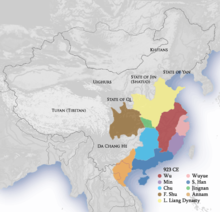
Back Vyf Dinastieë en Tien Koninkryke Afrikaans فترة الأسر الخمس والممالك العشر Arabic Cinco Dinastíes AST Петте династии и десетте царства Bulgarian পাঁচ রাজবংশ ও দশ রাজ্য কাল Bengali/Bangla རུས་མི་གཅིག་པའི་རྒྱལ་རབས་ཚན་པ་ལྔ། Tibetan Табан улас арбан ханлигуудай үе BXR Cinc Dinasties i Deu Regnes Catalan Ngū-dâi Sĕk-guók CDO پێنج زنجیرەی فەرمانڕەوایی و دە شانشینەکە CKB
| Five Dynasties and Ten Kingdoms | |||||||||||||||||
|---|---|---|---|---|---|---|---|---|---|---|---|---|---|---|---|---|---|
 The Later Liang (yellow) and contemporary kingdoms | |||||||||||||||||
| Traditional Chinese | 五代十國 | ||||||||||||||||
| Simplified Chinese | 五代十国 | ||||||||||||||||
| |||||||||||||||||
| Part of a series on the |
| History of China |
|---|
The Five Dynasties and Ten Kingdoms period (Chinese: 五代十國) was an era of political upheaval and division in Imperial China from 907 to 979. Five dynastic states quickly succeeded one another in the Central Plain, and more than a dozen concurrent dynastic states, collectively known as the Ten Kingdoms, were established elsewhere, mainly in South China. It was a prolonged period of multiple political divisions in Chinese imperial history.[1]
Traditionally, the era is seen as beginning with the fall of the Tang dynasty in 907 and reaching its climax with the founding of the Song dynasty in 960. In the following 19 years, Song gradually subdued the remaining states in South China, but the Liao dynasty still remained in China's north (eventually succeeded by the Jin dynasty), and the Western Xia was eventually established in China's northwest.
Many states had been de facto independent long before 907 as the late Tang dynasty's control over its numerous fanzhen officials waned, but the key event was their recognition as sovereign by foreign powers. After the Tang collapsed, several warlords of the Central Plain crowned themselves emperor. During the 70-year period, there was near-constant warfare between the emerging kingdoms and the alliances they formed. All had the ultimate goal of controlling the Central Plain and establishing themselves as the Tang's successor.
The last of the Five Dynasties and Ten Kingdoms regimes was Northern Han, which held out until Song conquered it in 979. For the next several centuries, although the Song controlled much of South China, they coexisted alongside the Liao dynasty, Jin dynasty, and various other regimes in China's north, until finally all of them were conquered by the Yuan dynasty.